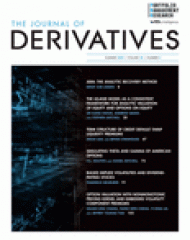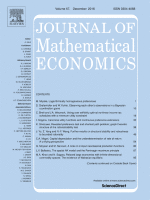publications
2023
-
 Measuring Information Flows in Option Markets: A Relative Entropy ApproachEric André, Lorenz Schneider, and Bertrand TavinJournal of Derivatives, Winter 2023
Measuring Information Flows in Option Markets: A Relative Entropy ApproachEric André, Lorenz Schneider, and Bertrand TavinJournal of Derivatives, Winter 2023In this article, we propose a methodology for measuring the information flows that underpin option price movements and for analyzing the distribution of these flows. We develop a framework in which information flows can be measured in terms of the relative entropy between the risk-neutral distributions obtained from implied volatility data at different dates. We set up a numerical methodology to compute such quantities using an empirical market dataset that corresponds to options written on the S&P 500 index. This methodology uses Normal Inverse Gaussian distributions for the log-return of the index. We apply our method to six years of daily data, from 2015 to 2021, and find that options with short maturities capture a greater share of new information. We also use a mixture of two exponential distributions to analyze the distribution of the information flows obtained. In this mixture, one component corresponds to frequent small values and the other to less frequent high values.
2022
-
 The impact of risk aversion and ambiguity aversion on annuity and saving choicesEric André, Antoine Bommier, and François Le GrandJournal of Risk and Uncertainty, Jul 2022
The impact of risk aversion and ambiguity aversion on annuity and saving choicesEric André, Antoine Bommier, and François Le GrandJournal of Risk and Uncertainty, Jul 2022We analyze the impact of risk aversion and ambiguity aversion on the competing demands for annuities and bequeathable savings using a lifecycle recursive utility model. Our main finding is that risk aversion and ambiguity aversion have similar effects: an increase in either of the two reduces annuity demand and enhances bond holdings. We obtain this unequivocal result in the flexible intertemporal framework of Hayashi and Miao (2011) by assuming that the agent’s preferences are monotone with respect to first-order stochastic dominance. Our contribution is then twofold. First, from a decision-theoretic point of view, we show that monotonicity allows one to obtain clear-cut results about the respective roles of risk and ambiguity aversion. Second, from the insurance point of view, our result that the demand for annuities decreases with risk and ambiguity aversion stands in contrast with what is usually found with other insurance products. As such, it may help explain the low annuitization level observed in the data.
2016
-
 Crisp monetary acts in multiple-priors models of decision under ambiguityEric AndréJournal of Mathematical Economics, Dec 2016
Crisp monetary acts in multiple-priors models of decision under ambiguityEric AndréJournal of Mathematical Economics, Dec 2016In axiomatic models of decision under ambiguity using a set of priors, a clear distinction can be made between acts which are affected by ambiguity and those which are not: the crisp acts. In these multiple-priors models, the decision maker is indifferent between holding a constant act or holding a non constant crisp act with the same expected utility, if it exists. In financial settings, we show that this indifference, together with the standard definition of monetary acts in the Anscombe–Aumann framework, implies that the investor ignores the variance of some assets, a behavior which conflicts with the assumption on which modern portfolio theory has been built. In this paper we establish the geometrical and topological properties of the set of priors that rule out the existence of non constant crisp acts. These properties in turn restrict what can possibly be an unambiguous financial asset.
2014
-
 Optimal portfolio with vector expected utilityEric AndréMathematical Social Sciences, May 2014
Optimal portfolio with vector expected utilityEric AndréMathematical Social Sciences, May 2014We study the optimal portfolio selected by an investor who conforms to Siniscalchi (2009)’s Vector Expected Utility’s (VEU) axioms and who is ambiguity averse. To this end, we derive a mean–variance preference generalised to ambiguity from the second-order Taylor–Young expansion of the VEU certainty equivalent. We apply this Mean–Variance Variability preference to the static two-assets portfolio problem and deduce asset allocation results which extend the mean–variance analysis to ambiguity in the VEU framework. Our criterion has attractive features: it is axiomatically well-founded and analytically tractable, it is therefore well suited for applications to asset pricing as proved by a novel analysis of the home-bias puzzle with two ambiguous assets.